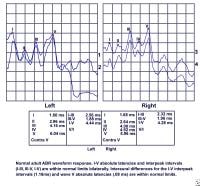
Axial T1-weighted image with contrast shows a cylindrical acoustic neuroma within the right internal auditory canal. The vestibulocochlear nerve assumes a crescent shape along the posterior and inferior aspects of the middle portion of the canal as the two components begin to divide.

The point of separation may vary among patients. The vestibular and cochlear components of the eighth cranial nerve usually enter the meatus as a single unit, and they divide into separate nerves within the internal auditory canal. Cross-sectional imaging viewed perpendicular to the long axis of the canal consistently shows the nerve in the anterosuperior quadrant of the internal auditory canal. The shape of the facial nerve is tubular. They enter the meatus, or porus acusticus, of the internal auditory canal as two separate structures. These nerves emerge from the brainstem at the pontomedullary junction and course through the cerebellopontine angle cistern. The anatomy of the facial and vestibulocochlear nerves must be understood to reliably evaluate and precisely localize pathology within the internal auditory canal and cerebellopontine angle. Imaging plays a crucial role in both the detection and posttherapeutic management of these lesions. Treatment of vestibular schwannomas is aimed at removing the lesion or arresting its growth to prevent further neurologic impairment. Symptoms related to increased intracranial pressure and cerebellar involvement such as ataxia may occur. As the size of the tumor increases, it may extend into the posterior fossa. Because this tumor grows slowly, symptoms evolve over months and years and the lesion can become quite large before it is detected. The accompanying facial nerve within the internal auditory canal is more tolerant of this local mass effect, and facial nerve symptoms such as ipsilateral facial paralysis are uncommon. Sensorineural hearing loss is the result of extrinsic pressure from compression of the cochlear division of the eighth cranial nerve within the internal auditory canal by the tumor arising from the adjacent vestibular division. Patients usually present with unilateral hearing loss, often accompanied by tinnitus and vertigo. They almost always arise from Schwann cells of the vestibular portion of the vestibulocochlear nerve therefore, vestibular schwannoma is the preferred term. Key Words: acoustic neuroma, cerebellopontine angle, vestibulocochlear nerve, internal auditory canalĪcoustic neuromas, common benign tumors accounting for 10% of primary intracranial tumors, are the most common tumor in the cerebellopontine angle cistern. Although contrast-enhanced T1-weighted imaging remains the most commonly employed method for evaluation, high-resolution T2-weighted imaging provides a sensitive alternative for tumor detection. Magnetic resonance imaging is the most sensitive method of detection and also plays an important role in the follow-up of patients treated with both surgery and stereotactic radiosurgery. These tumors have specific imaging characteristics that can help differentiate them from other lesions that occur in the cerebellopontine angle cistern of the posterior fossa. Joseph’s Hospital and Medical Center, Phoenix, ArizonaĪcoustic neuromas are common benign lesions that can result in sensorineural hearing loss. Barrow-ASU Center for Preclinical Imagingĭivision of Neuroradiology, Barrow Neurological Institute, St.Department of Translational Neuroscience.Department of ENT and Skull Base Surgery.For Providers & Researchers Show submenu.

Parkinson’s Disease & Movement Disorders.Center for Transitional Neuro-Rehabilitation.


 0 kommentar(er)
0 kommentar(er)
